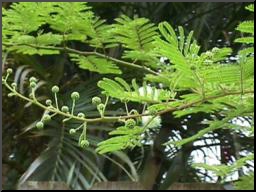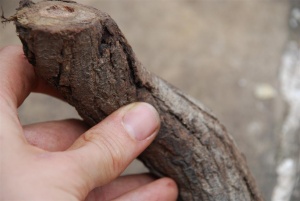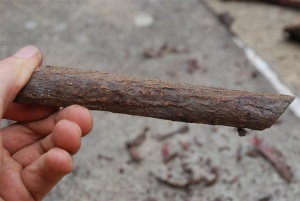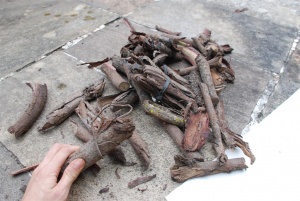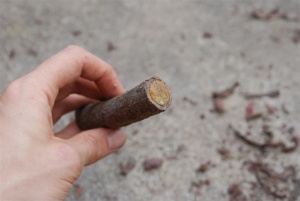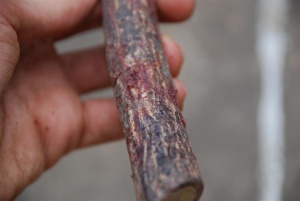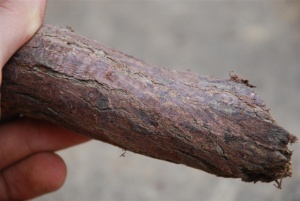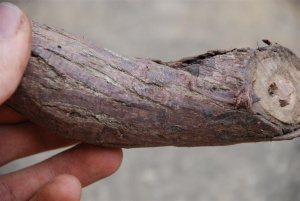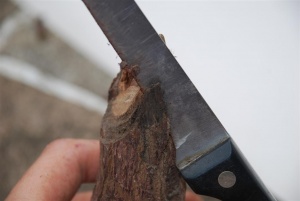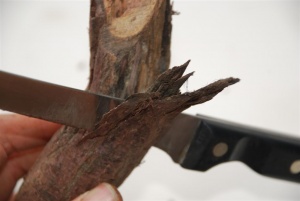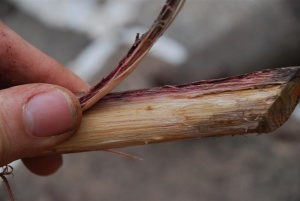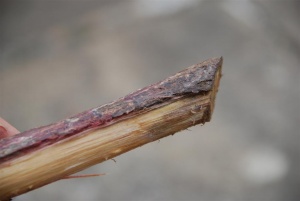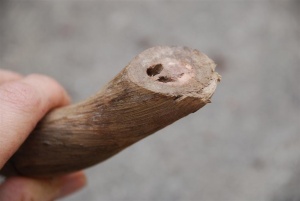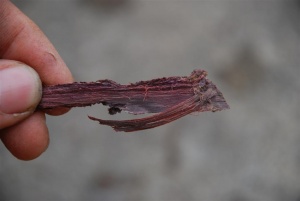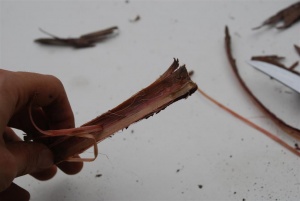Difference between revisions of "Mimosa hostilis"
Endlessness (Talk | contribs) |
Endlessness (Talk | contribs) |
||
| Line 3: | Line 3: | ||
* Root Bark contains DMT - 0.31% to 0.57% (Schultes 1977) | * Root Bark contains DMT - 0.31% to 0.57% (Schultes 1977) | ||
* Inner root bark contains up to 2% active alkaloids (Extractions from DMT-Nexus and others) | * Inner root bark contains up to 2% active alkaloids (Extractions from DMT-Nexus and others) | ||
| + | * 3% NMT and 2-Methyl-1,2,3,4-Tetrahydro-Beta-Carboline ([https://www.dmt-nexus.me/forum/default.aspx?g=posts&t=10553 Analysis of jungle spice], [https://www.dmt-nexus.me/forum/default.aspx?g=posts&t=19320 Analysis of red/yellow/white spices | ||
|Jurema | |Jurema | ||
}} | }} | ||
</onlyinclude> | </onlyinclude> | ||
| + | |||
| + | [[Image:Mimosa Hostilis.jpg|thumb|right|300px|''Mimosa tenuiflora'']] | ||
| + | |||
| + | == General Plant Info == | ||
| Line 13: | Line 18: | ||
To date no β-carbolines such as harmala alkaloids have been detected in ''Mimosa tenuiflora'' decoctions, however the isolation of a new compound called "Yuremamine" from ''Mimosa tenuiflora'' as reported in 2005 represents a new class of phyto-indoles <ref>Vepsäläinen, Jouko J.; Auriola, Seppo; Tukiainen, Mikko; Ropponen, Nina & Callaway, J.C. (2005). "Isolation and characterization of yuremamine, a new phytoindole". Planta Medica, 71: 1053-1057. URL: http://www.ncbi.nlm.nih.gov/pubmed/16320208</ref>. This may explain the reported oral activity of DMT in Jurema without the addition of an MAOI. Imported MHRB typically requires the addition of an MAOI in the preparation of ayahuasca. | To date no β-carbolines such as harmala alkaloids have been detected in ''Mimosa tenuiflora'' decoctions, however the isolation of a new compound called "Yuremamine" from ''Mimosa tenuiflora'' as reported in 2005 represents a new class of phyto-indoles <ref>Vepsäläinen, Jouko J.; Auriola, Seppo; Tukiainen, Mikko; Ropponen, Nina & Callaway, J.C. (2005). "Isolation and characterization of yuremamine, a new phytoindole". Planta Medica, 71: 1053-1057. URL: http://www.ncbi.nlm.nih.gov/pubmed/16320208</ref>. This may explain the reported oral activity of DMT in Jurema without the addition of an MAOI. Imported MHRB typically requires the addition of an MAOI in the preparation of ayahuasca. | ||
| − | |||
| − | == | + | == Identification == |
== Alkaloid content == | == Alkaloid content == | ||
Revision as of 18:24, 4 November 2011
| Mimosa hostilis |
|
|---|---|
| Jurema |
Contents
General Plant Info
Mimosa hostilis is the former scientific name for Mimosa tenuiflora, and the two names are synonymous [1][2]. The older name is still widely know due to its presence in the literature and as distributers of botanical products still use the older term. M. tenuiflora is an entheogen known as Jurema, Jurema Preta, Black Jurema, and Vinho de Jurema. Dried Mexican Mimosa Hostilis root bark has been recently shown to have a DMT content of about 1%. The stem bark has about 0.03% DMT.
To date no β-carbolines such as harmala alkaloids have been detected in Mimosa tenuiflora decoctions, however the isolation of a new compound called "Yuremamine" from Mimosa tenuiflora as reported in 2005 represents a new class of phyto-indoles [3]. This may explain the reported oral activity of DMT in Jurema without the addition of an MAOI. Imported MHRB typically requires the addition of an MAOI in the preparation of ayahuasca.
Identification
Alkaloid content
Extraction teks
For extracting DMT , any of the extraction teks described here will work.
Yuremamine is sensitive to heat and pH changes so only cold water (or alcoholic) soak will retrieve it.
Cultivation
Growing: Mimosas aren´t cold proof. For outdoor growing they deserve a sunny place with leachy middle nutrient soil. Throughout the vegetation are copiously watered, in winter the watering is tied down on to the minimum. They are breeding with the seeds, but can be breeded with the cutting also.
Suppliers
Refinery for the Purpose of Extraction
Mimosa Hostilis Root Bark can be acquired in different stages of preparation. Usually it is sold as whole, shredded or pre-powdered root-bark, but one may have access to the whole root—usually when harvested directly.
- The whole root must cleaned and stripped of its inner root-bark while discarding the rest of the root.
- The whole root-bark must generally be torn by hand, cut, or smashed with a blunt object prior to shredding.
- The shredded can only be used "as-is" if the pieces are small enough.
- If the pieces are too big, the alkaloids will not be as readily exposed for extraction.
- The pre-powdered can always be used "as-is".
Since each stage denotes a successively more refined preparation, the following will detail the entire process of refinery. One need only follow the procedure from its characteristic stage of refinery through to the desired stage for extraction.
The Root
| Note: | Only the Inner Root Bark is necessary for extraction, the core and outer parts are to be discarded! |
| Root preparation | ||||
|---|---|---|---|---|
|
Pictured below is its original after being harvested from the plant. Notice the middle core is quite distinct from the root-bark, the outer bark is much more brown: |
Cleaning the root
Peeling the Inner Root Bark
| Peeling the Inner Root Bark | |||||
|---|---|---|---|---|---|
|
Once the outermost part has been removed, peel off the Inner Root Bark to separate it from the core. This can easily be accomplished immediately by hand, though the use of a knife may be helpful. Here's the inner core which is to be discarded: |
Result of root preparation
| Result of root preparation | ||
|---|---|---|
|
The peeled inner root-bark now needs to dry. This may be accomplished by simply leaving it in the sun. Here's how it should look: |
Breaking the rootbark up
| Breaking the rootbark up | |
|---|---|
|
The pieces/strips of inner root-bark require further refinery to expose a larger surface area and increase the availability of the alkaloids for extraction. If storage is desired, then the whole pieces are preferable, as the alkaloids are less exposed and thus better protected. First strip the pieces further into thinner layers.... |
References
- ↑ USDA, ARS, National Genetic Resources Program. Germplasm Resources Information Network - (GRIN) [Online Database]. National Germplasm Resources Laboratory, Beltsville, Maryland. URL: http://www.ars-grin.gov/cgi-bin/npgs/html/taxon.pl?24430
- ↑ Lewis, G.P. (1987) Royal Botanic Gardens, Kew 369 pp Legumes of Bahia.
- ↑ Vepsäläinen, Jouko J.; Auriola, Seppo; Tukiainen, Mikko; Ropponen, Nina & Callaway, J.C. (2005). "Isolation and characterization of yuremamine, a new phytoindole". Planta Medica, 71: 1053-1057. URL: http://www.ncbi.nlm.nih.gov/pubmed/16320208

